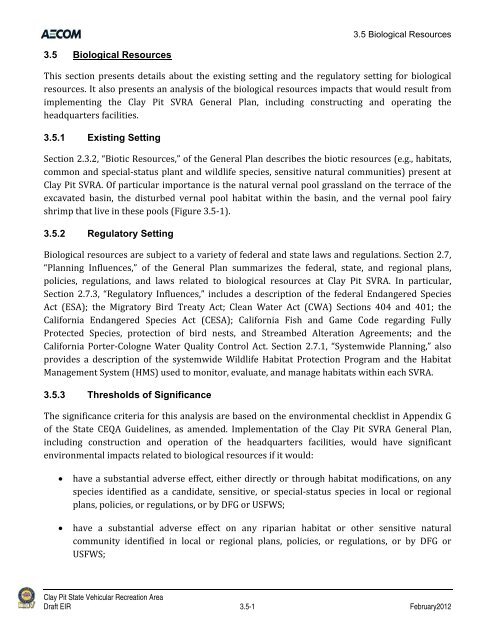Draft Environmental Impact Report - California Off Highway Vehicle ...
Draft Environmental Impact Report - California Off Highway Vehicle ...
Draft Environmental Impact Report - California Off Highway Vehicle ...
Create successful ePaper yourself
Turn your PDF publications into a flip-book with our unique Google optimized e-Paper software.
3.5 Biological Resources<br />
3.5 Biological Resources<br />
This section presents details about the existing setting and the regulatory setting for biological<br />
resources. It also presents an analysis of the biological resources impacts that would result from<br />
implementing the Clay Pit SVRA General Plan, including constructing and operating the<br />
headquarters facilities.<br />
3.5.1 Existing Setting<br />
Section 2.3.2, “Biotic Resources,” of the General Plan describes the biotic resources (e.g., habitats,<br />
common and special‐status plant and wildlife species, sensitive natural communities) present at<br />
Clay Pit SVRA. Of particular importance is the natural vernal pool grassland on the terrace of the<br />
excavated basin, the disturbed vernal pool habitat within the basin, and the vernal pool fairy<br />
shrimp that live in these pools (Figure 3.5‐1).<br />
3.5.2 Regulatory Setting<br />
Biological resources are subject to a variety of federal and state laws and regulations. Section 2.7,<br />
“Planning Influences,” of the General Plan summarizes the federal, state, and regional plans,<br />
policies, regulations, and laws related to biological resources at Clay Pit SVRA. In particular,<br />
Section 2.7.3, “Regulatory Influences,” includes a description of the federal Endangered Species<br />
Act (ESA); the Migratory Bird Treaty Act; Clean Water Act (CWA) Sections 404 and 401; the<br />
<strong>California</strong> Endangered Species Act (CESA); <strong>California</strong> Fish and Game Code regarding Fully<br />
Protected Species, protection of bird nests, and Streambed Alteration Agreements; and the<br />
<strong>California</strong> Porter‐Cologne Water Quality Control Act. Section 2.7.1, “Systemwide Planning,” also<br />
provides a description of the systemwide Wildlife Habitat Protection Program and the Habitat<br />
Management System (HMS) used to monitor, evaluate, and manage habitats within each SVRA.<br />
3.5.3 Thresholds of Significance<br />
The significance criteria for this analysis are based on the environmental checklist in Appendix G<br />
of the State CEQA Guidelines, as amended. Implementation of the Clay Pit SVRA General Plan,<br />
including construction and operation of the headquarters facilities, would have significant<br />
environmental impacts related to biological resources if it would:<br />
have a substantial adverse effect, either directly or through habitat modifications, on any<br />
species identified as a candidate, sensitive, or special‐status species in local or regional<br />
plans, policies, or regulations, or by DFG or USFWS;<br />
have a substantial adverse effect on any riparian habitat or other sensitive natural<br />
community identified in local or regional plans, policies, or regulations, or by DFG or<br />
USFWS;<br />
Clay Pit State Vehicular Recreation Area<br />
<strong>Draft</strong> EIR 3.5-1 February2012








